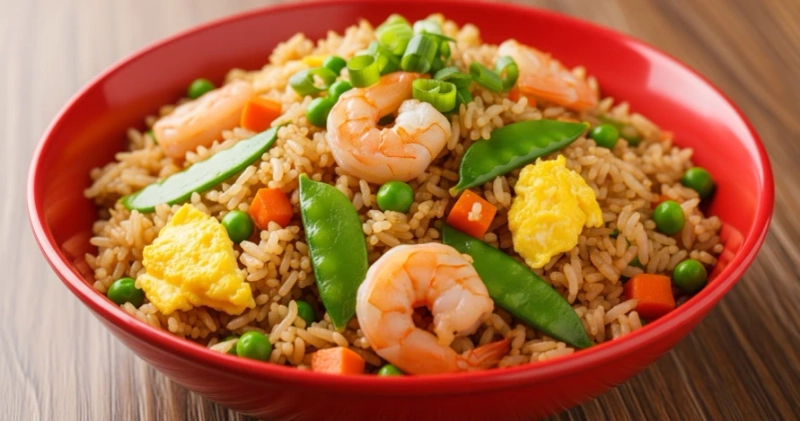Rice is a living thing, even after it is cooked. When it is first boiled (or steamed), each grain is plump with moisture, the starches swollen and tender.
However, while this may be perfect for a bowl of steamed rice, it is disastrous for fried rice. The high heat of a wok or skillet demands rice that can hold its own, grains that will sear rather than steam, grains that will absorb the flavors of oil, garlic, and soy without turning to paste.
As rice sits, especially overnight in the refrigerator, the moisture content drops. The starches recrystallize and firm up, giving each grain a resilience that fresh rice lacks.
This transformation is subtle but profound. The surface of each grain becomes slightly drier, allowing it to brown and crisp when it hits the hot oil. The interior remains tender, but no longer full of water. The result is rice that fries, not steams; rice that takes on the depth of a well-seasoned wok and the sharp notes of aromatics without dissolving into a starchy mush.
Choosing the Right Rice
Not all rice is created equal when it comes to fried rice. The ideal candidates are varied with a balance of stickiness and individuality. Jasmine rice, with its floral aroma and slightly sticky texture, is a classic choice. It clumps just enough to make each bite cohesive, but not so much that it becomes gummy. Medium-grain rice, often used in Japanese and Korean cooking, is also a good choice. Its grains are shorter and plumper than long-grain varieties, and they offer a satisfying chew that stands up to the demands of the wok.
Long-grain rice, like basmati, can work, but it tends to stay separate, lacking the gentle cohesion that makes fried rice so satisfying to eat. Short-grain rice, while excellent for risotto or sushi, is usually too sticky for fried rice. It typically turns the dish into a dense, heavy mass rather than a textured enjoyment.
In other words, the best rice options for fried rice are those that achieve a balance when cooked and then rested. Their grains are individual but not isolated, tender but not soft, and they’re ready to absorb the flavors without disintegrating into a mushy mess.
Preparing Fried Rice
The rice for fried rice should be cooked just until tender, and then spread out on a tray or a wide dish to cool quickly. This prevents the grains from continuing to steam: they will soften in their own heat. Once cool, rice is to be transferred to the refrigerator, uncovered, to dry out overnight. Some cooks swear by leaving the rice uncovered in the fridge for up to twenty-four hours, allowing the surface moisture to evaporate completely.
When the time to fry comes, rice should be broken up gently with the fingers or a fork. The goal is to separate the grains without crushing them.
Hitting the Pan
The magic of fried rice happens in the first minutes in the pan. The oil must be hot, shimmering just shy of smoking, ready to sear the rice and lock in its texture. The rice is to be added in stages, to allow each batch to make contact with the oil and the heat. The sound is as important as the sight: a sharp sizzle announces rice grains taking on a golden hue at the edges.
The rice, once soft and yielding, now has a slight resistance, a crispness at the edges that gives way to a tender center. It is ready to take on the flavors of garlic, ginger, scallions, and whatever else you choose to add.
Rice needs to be stirred, not constantly, but with purpose, allowing it to sear in places, to develop those flecks of golden brown that give fried rice its character: a toss, a pause, then another toss. It should move enough to cook evenly, but not so much that it steams in its own moisture.
The aromatics are to be added when the rice is hot but not yet done. They sizzle, release their fragrance into the oil, which in turn coats every grain. The scent rises, sharp and savory. Finally, add some soy sauce and a touch of sugar or a splash of mirin.
Personal Touch
Every cook has their own way with fried rice. Some prefer adding some fish sauce for depth, others — a pinch of monosodium glutamate (MSG). Some like their fried rice studded with shrimp, others with chunks of Chinese sausage or crispy bits of bacon. Any of these will do the trick! Fried rice is a very versatile dish.
Regardless of the additions, the foundation will always remain the same: rice that has been given the time to dry. The best fried rice doesn’t require the most expensive ingredients or the most complicated techniques; it just requires patience.
Fired Rice Is More than Saving Leftovers
Fried rice is more than a way to use up leftovers. It is a dish that rewards patience and attention. The difference between fresh rice and day-old rice in the pan is the difference between a meal that is eaten out of necessity and one that is being savored. Sometimes, the best things come not from what is new but from what has been allowed to rest, change, and become something better with time. Just like with all things in life!
All the same, everyone everywhere can be content knowing that the secret to great fried rice doesn’t lie in a rare ingredient. It is simply a matter of waiting. That is the alchemy of fried rice: turning yesterday’s rice into today’s masterpiece.


